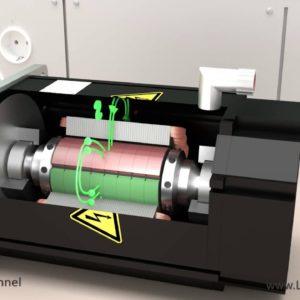This industrial robot needs a drive with particularly high demands. Not only does the robot have to be able to
accelerate and decelerate fast – also precisely positioning is required. In fact, here is a three-phase servomotor
installed. In this video we will first clarify the term
servomotor and servo drive in general, then the 3-phase-servo drive. The servomotor is a part of a servo drive
– whether brushless DC motor, synchronous or a robust asynchronous motor. But one thing in common is the detection of the rotor position by a sensor. This can be a resolver or an encoder – in
this case you see an incremental encoder. This sensor device gives feedback to a controller to keep for example the rotational speed or torque constant or to reach the target position as fast as possible.
A servo motor system includes the servo motor with its feedback device, a servo amplifier and a controller. But how these devices work together? The servo controller sends low voltage control signals for position, speed or torque to the servo amplifier. Now these commands are amplified up to high power, which the motor can use. The electrical pulses of a sensor are sent
back to the amplifier. This amplifier uses this information to control speed and rotor position. The job of the servo motor controller, also
named as the motion controller, is to close the loop on the system.

By constantly interchanging data with the
servo amplifier, the motor parameters like torque, speed or position can be adjusted
immediately. Some manufacturers offer modules, which combine the controller and the amplifier. So you would have fewer parts, fewer connections and a smaller footprint. Talking about an AC servo motor you usually mean a 3 phase synchronous motor whose rotor field is excited by permanent magnets. So you can get a very powerful and brushless motor of small size. The stator winding produces a rotating magnetic field whose rotating speed and force is controlled by the amplifier and controller. In order to position quickly, all these motors must have a low moment of inertia, which can be achieved by an elongated shape.
The functioning of a synchronous motor was already explained in another video of our learnchannel. Please check our playlist. Watch also our next videos!.

